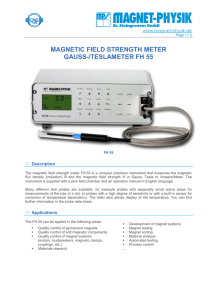Research Topic Analysis
advertisement
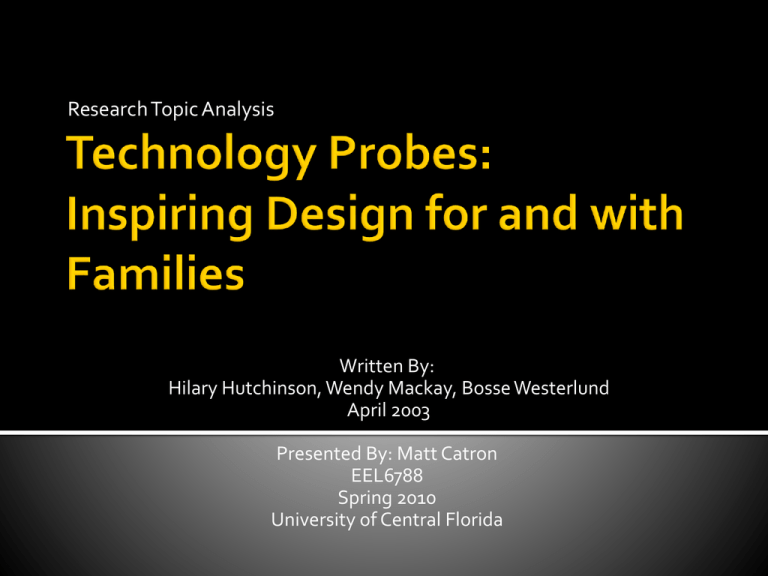
Research Topic Analysis Written By: Hilary Hutchinson, Wendy Mackay, Bosse Westerlund April 2003 Presented By: Matt Catron EEL6788 Spring 2010 University of Central Florida “Bowling Alone” – Robert Putnam Technology has lead us to a loss of “social capital” Activity % Change in Last 25 Years Attending Club Meetings 58% drop Family Dinners 43% drop Having Friends Over 35% drop www.bowlingalone.com HomeNet Study (Carnegie Mellon) Technology isolates family and friends Has also increased daily stress levels Can be positive when used for communication with family and friends http://homenet.hcii.cs.cmu.edu/ http://www.facebook.com/ Conflicting information presents the question: “What is the value of computer technology as it permeates our lives???” It is important to study how technology can be used to support communication in everyday life “Design and understand the potential for new technologies that support communication amongst diverse, distributed, multigenerational families ” This research is part of the interLiving project Design and deploy 2 technologies, messageProbe and videoProbe Studies include families from US, Sweden, and France Find a design strategy which allows family members to be key participants in the design Typical Approach: 1st Interview Families 2nd Create a design 3rd Test and see what they liked / disliked At the same time, family participants cannot become the designers themselves The solution is to use “technology probes” Probe – “An instrument to find out about the unknown” Technologies which are “simple, flexible, and adaptible” Used for co-designing technologies along with users This is a multidisciplinary area of study Discipline Why its needed Social Science “Understanding the needs and desires of users in a real-world setting” Engineering “Field testing the technology” Design “Inspiring users and researchers to think about new technologies” Data collected is not ‘unbaised’ The technology probe should and will interact with the users’ behavior Also, the users interpretation of the technology over time is important They must work (in a real world setting) Although it may be a rapidly prototyped device, it is more than just a demonstration Minor details are important Flexibility and adaptability are important Allow users to come up with their own uses after a period of time Probes must be open-ended, allowing users to freely decide how best to use them Future ideas can incorporate these findings Feature Probe Prototype Functionality Simpler More complex Flexibility Open-ended More focused Usability Not so important Primary concern Logging A primary goal Maybe, but secondary Design Phase Appear Early Appear Later Main goal is to experiment with different design methodologies Particularly with families and individuals within a family http://interliving.kth.se http://interliving.kth.se/finaldeliv/interLivingbrochure-low.pdf Digital post-its in a zoomable space Multiple users can access it at the same time from different places Contains just an LCD tablet and pen Limited to just a few family members Interface was a minimal as possible, to most closely relate to pen and paper USA Family Father was the only one who regularly used it Mother preferred to just use the phone Kids were too busy to check it Grandfather would write on pen and paper 1st because there was no delete function Swedish Families (2) Woman tended to make use of this much more than men Kids played games such as connect-the-dots All families suggested a visual or audio cue when new post-its become available Helpful in revealing communication patterns and technology needs/desires Many messages involved thing like coordinating to run errands and get stuff done. Possibility for future research Monitor with a camera and remote Pictures can be taken and viewed across the network Remote can be used to browse images Pictures ‘fade’ over time and eventually disappear Real-time video is tough to implement in a home application (2003) Still images support both synchronous and asynchronous communication This also requires family members to interact with the probe French Families (2) Mostly used to make a funny face and send the picture Sometimes they would take pictures of hand written messages to send messageProbe and videoProbe helped indentify two areas for further study: Family coordination: ▪ Study participants had ideas for this, including: ▪ Shared calendars embedded into the fridge and on cellphones. ▪ Voice activated key chains to display schedule Playful interaction ▪ Future prototypes should continue to encourage this type of behavior Technology probes are a promising design tool Help to reveal practical needs and playful desires Provided real-life use scenarios Introduced families to new types of technologies GOOD “Technology Probe” is a great way to identify a need Also, provides great ideas for fulfilling that need BAD Outdated research examples. Technology has been revolutionized several times in the last 7 years. Encourage the use of this in industry in addition to in research and in academia Use of current technologies can be just as beneficial as developing new technologies.




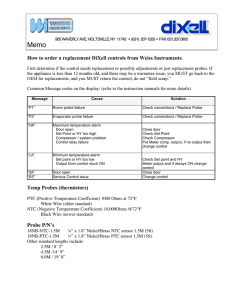

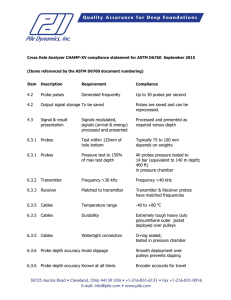

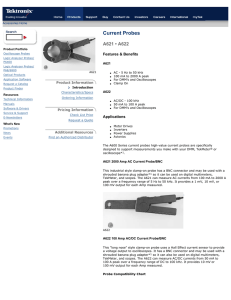
![[INTRODUCTION] This document describes the command line](http://s2.studylib.net/store/data/018104671_1-a99544a0f13d2917cc827d582ebe2bf4-300x300.png)
